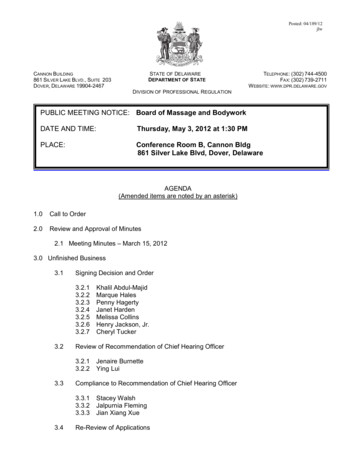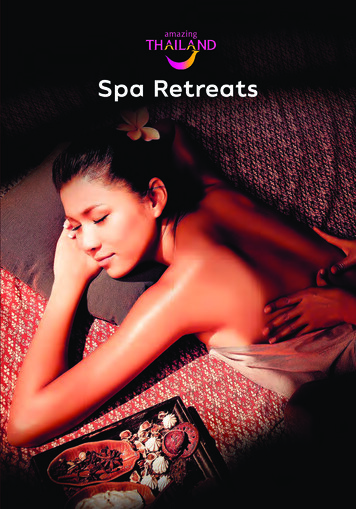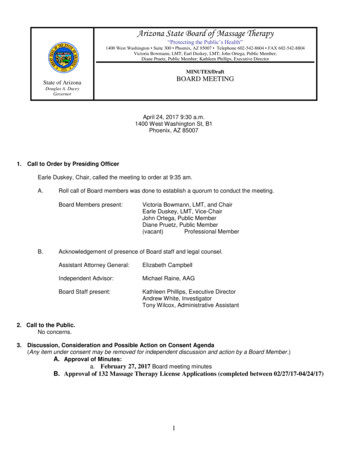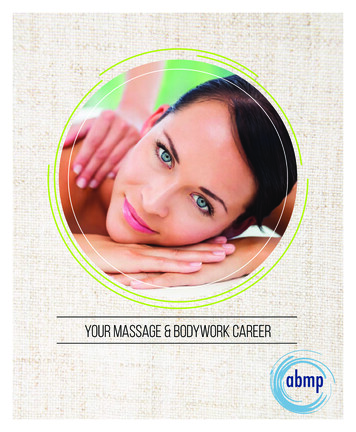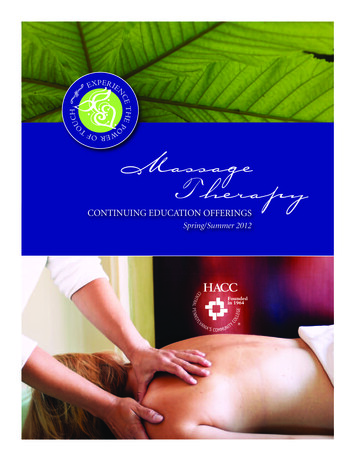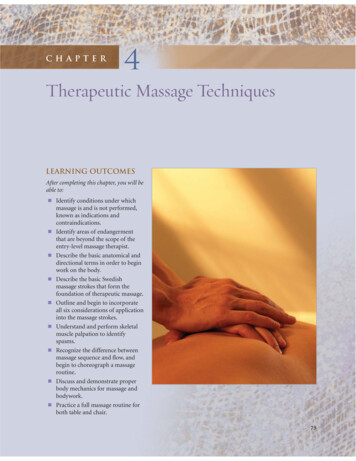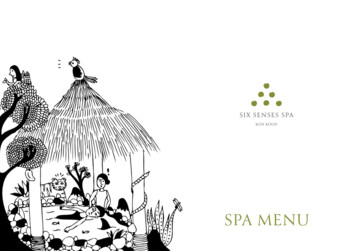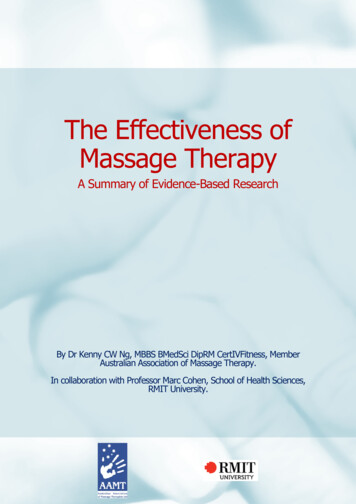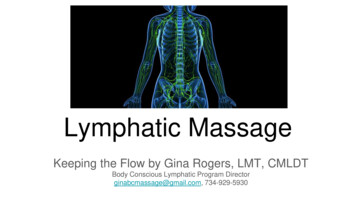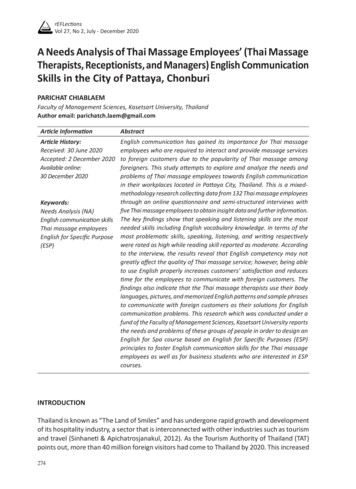
Transcription
MASSAGE AND BODYWORKGuidelinesfor Practicewith COVID-19ConsiderationsFederation of State Massage Therapy Boardsfsmtb.org2020.05.19FSMTB ALL RIGHTS RESERVEDGUIDELINES FOR PRACTICE WITH COVID-19 CONSIDERATIONS 1
FSMTB MISSION STATEMENTThe mission of the Federation is to support its Member Boards in their work to ensure thatthe practice of massage therapy is provided to the public in a safe and effective manner.Copyright 2020. Federation of State Massage Therapy Boards. All rights reserved.Limited permission is granted to use or reproduce all or parts of this document. Use orreproduction of this document for commercial or for-profit purposes is strictly prohibited.Any authorized reproduction of this document shall display the notice: “Copyright 2020 bythe Federation of State Massage Therapy Boards. All rights reserved.” Or, if a portion of thedocument is reproduced or incorporated in other materials, such materials shall include thefollowing credit: “Portions of these materials are copyrighted by the Federation of StateMassage Therapy Boards. All rights reserved.”Address copyright permission requests in writing to: Executive Director, FSMTB, 7300 CollegeBoulevard, Suite 650, Overland Park, Kansas, 66210.FSMTB ALL RIGHTS RESERVEDGUIDELINES FOR PRACTICE WITH COVID-19 CONSIDERATIONS 2
ContentsIntroduction4Facility Cleanliness, Disinfection,and Disease Prevention6Cleaning and Disinfecting Products7Guidelines for Specific Facility Areas8The Reception Area8The Retail Area9The Restroom9Hallways10The Session Room10Specialized Spa Equipment11The Break Room11The Laundry Room12Onsite and Outcall Locations13Linen Management14Guidelines for Policies and Procedures16Changes to Session Scheduling16Changes to Health Screening Procedures17Changes to Client Arrival Procedures18Clients at High Risk18Changes to Session Procedures19Client Follow Up Procedures20Client Communication2022Hand Hygiene22Use of Alcohol-Based Hand Sanitizers23Respiratory Hygiene And Cough Etiquette24Use of Appropriate PersonalProtective Equipment25Face Masks25Protective Clothing26Gloves26Self-Monitoring for Signs andSymptoms of COVID-1927Exposure or Expected Exposure to COVID-1927COVID-19 Testing27School Cleanliness, Disinfection,and Disease Prevention29Classroom Policies and Procedures31Students at High Risk32Self-Monitoring for SignsAnd Symptoms of COVID-1932Changes To Student, Faculty, andStaff Arrival Procedures33COVID-19 Training33References & ess on WorkdaysFSMTB ALL RIGHTS RESERVED2815Changes to Client Informed ConsentGuidelines for Practitioner HygieneGuidance for Massage SchoolsGUIDELINES FOR PRACTICE WITH COVID-19 CONSIDERATIONS 3
IntroductionClean facilities, proper practitionerhygiene, procedures to ensureclient safety, and disease preventionprotocols have long been a cornerstoneof professional massage and bodyworkpractice. The outbreak and rapidspread of coronavirus 19 (COVID-19)highlights the need for renewedattention and increased vigilancein these areas as states lift stay-athome orders (also called stay-in-placeorders) and massage and bodyworkpractitioners return to practice.The Federation of State Massage Therapy Boards (FSMTB) ispleased to present the Guidelines for Practice with COVID-19Considerations. This document contains recommendations andguidelines for massage and bodywork practitioners to mitigatethe spread of COVID-19.The intent of this document is to provide a resource to FSMTBMember Boards and Agencies, massage and bodyworkprofessionals, and massage school staff in order to supportpublic protection. Readers are encouraged to refer toand use the FSMTB Guidelines for Practice with COVID-19Considerations within the confines of the regulatory structuresof their respective states.FSMTB recognizes that some customization and flexibilityare necessary to allow these concepts to be of assistance ineach jurisdiction and practice setting. Each massage practicewill have its own time frame for returning to work based onthe state’s stay-at-home orders, supply of personal protectiveequipment (PPE), funding for massage programs, availabilityof COVID-19 tests, COVID-19 testing rates, and stable or fallingCOVID-related hospitalization rates for two weeks or more.These recommendations and guidelines do not replace anydirectives or guidance provided by federal or state agencies,regulatory boards, or other authorities having jurisdiction.Where conflicts occur, the stricter requirement will apply.FSMTB ALL RIGHTS RESERVEDGUIDELINES FOR PRACTICE WITH COVID-19 CONSIDERATIONS 4
The Centers for Disease Control and Prevention (CDC) offersextensive guidelines for healthcare professionals related topreventing disease and the spread of COVID-19.1 At the coreof CDC recommendations for healthcare professionals is theconcept of Standard Precautions.The CDC defines Standard Precautions as:“The minimum infection preventionpractices that apply to all patient care,regardless of suspected or confirmedinfection status of the patient, in anysetting where health care is delivered.”No matter the overall health picture of a client, massageprofessionals must apply minimum infection preventionpractices with strict attention to protect the client andthemselves from the spread of infection.2The FSMTB Guidelines for Practice with COVID-19Considerations references Standard Precautions andTransmission-Based Precautions, CDC protocols and adaptsthem to the specific practice environment of massage andbodywork. Whenever possible, this document reflects specificCDC recommendations to provide guidance on facilitycleanliness and disinfection, use of PPEs, facility policiesand procedures, and requirements for massage practitionerhygiene.See the Resources section for a complete list of thegovernmental guidelines that inform this document. In somecases, when appropriate, specific documents or researchstudies are referenced and listed in the References section.Please note that COVID-19 is a rapidly evolvingsituation. The FSMTB affirms the importance ofregulated massage and bodywork professionalswho are adequately informed to practice safelyand competently. This document will be modifiedas necessary when further relevant informationbecomes available. We invite both your use of theseGuidelines for Practice with COVID-19 Considerationsand your ongoing interest in future versions of thisessential resource.FSMTB ALL RIGHTS RESERVEDGUIDELINES FOR PRACTICE WITH COVID-19 CONSIDERATIONS 5
GUIDELINES FORFacility Cleanliness,Disinfection, andDisease PreventionInfection control guidance from the CDC reminds healthcareproviders that COVID-19 is spread primarily through personto-person contact. Infectious respiratory droplets, producedwhen someone with COVID-19 coughs, sneezes, or speaks, canland on the eyes, mouth, or nose of an uninfected person, orbe inhaled by an uninfected person standing close by. Smallerdroplets may hang in the air for a period of time, while heavierdroplets fall to surfaces. An uninfected person might toucha contaminated surface and then touch their face, mouth,or nose giving the virus entry to the body. Protocols thatreduce the dispersal of respiratory droplets and the regulardisinfection of surfaces in a massage workplace help reducethe spread of COVID-19.3,4Here, guidance is provided on cleaning and disinfectingproducts, cleaning and disinfection of different areasof a massage facility, methods that reduce the entry ofCOVID-19 to a facility, and the management of potentiallycontaminated linens.FSMTB ALL RIGHTS RESERVEDGUIDELINES FOR PRACTICE WITH COVID-19 CONSIDERATIONS 6
Cleaning andDisinfectingProductsFSMTB ALL RIGHTS RESERVED»Commercial or household-grade products maybe used for routine cleaning such as washingsurfaces with soap and water to remove visiblesoil, dusting, and cleaning glass surfaces with aglass cleaner.»Homemade cleaning products (e.g., vinegar andessential oils) are not approved cleaning agentsor disinfectants.»Disinfectants registered by the EnvironmentalProtection Agency (EPA) must be used todisinfect surfaces that may become contaminatedthrough touch or respiratory droplets during aworkday.»Disinfect surfaces by applying an EPA-registereddisinfectant to the surface, following labeldirections. If surfaces are dirty, they must first becleaned to remove dirt or impurities, followed bydisinfection.»Fabrics such as curtains or upholstery aredisinfected with fabric-specific EPA-registereddisinfectants.»Find an EPA-registered disinfectant specific foruse against SARS-CoV-2 (the virus that causesCOVID-19) at tants-use-against-sars-cov-2.»Follow the label directions for the use of allcleaning and disinfecting products and followrecommended contact times (amount of time asurface should be visibly wet with the product).»Some cleaning and disinfection productsrequire ventilating the space by opening doorsand windows and by running fans to reduce theairborne presence of cleaning chemicals.»Some cleaning and disinfection products requirewearing cleaning gloves, eye protection, and aface mask.GUIDELINES FOR PRACTICE WITH COVID-19 CONSIDERATIONS 7
Guidelines forSpecific FacilityAreasMassage professionals and massage business owners areencouraged to consider the areas of their businesses that need tobe regularly disinfected, how surfaces are touched or potentiallycontaminated, how different types of surfaces can be disinfected(e.g., disinfecting fabrics such as curtains or upholstery asopposed to hard surfaces such as countertops), the disinfectionproducts needed to respond effectively to COVID-19, and ways toreduce the likelihood that COVID-19 could enter their facilities.THE RECEPTION AREA»Declutter and remove items from thereception area that might becomecontaminated and require repeateddisinfecting (e.g., magazines, pamphlets,knickknacks, candy bowls, the tea station,etc.).»Organize the reception area to promotephysical distancing by removing chairs,spacing chairs 6 feet (2 meters) apart,placing tape in the shape of an X on areaswhere people should not sit or stand, orby blocking off the reception area andescorting clients directly to session rooms(see Policies and Procedures).»»Place signs (available from the CDC)at eye level to educate clients aboutrespiratory hygiene and cough etiquette,hand hygiene, symptoms of COVID-19, andphysical distancing.»Disinfect high-touch surfaces (surfacesthat are handled frequently throughoutthe day by numerous people) betweenclients with an EPA-registered disinfectant.High-touch surfaces include door handles,counters, tabletops, pens or pencils usedto complete paperwork, clipboards,desks, light switches, water fountains, andpayment touch screens.Make alcohol-based hand sanitizer (6095% alcohol) easily accessible to clientsentering the facility and encourage clientsto sanitize their hands upon arrival.»Ventilate the reception area often byopening doors and windows to circulatefresh air and by using HEPA air filtrationsystems when they are available.»Make tissues and no-touch trash cansavailable for the practice of respiratoryhygiene and cough etiquette.»»Encourage clients to wear their own facemask to the facility. Provide surgical orother disposable face masks to thosewithout a face covering upon arrival.Clean floors at the end of the dayby mopping hard floors with an EPAregistered floor cleaner. Vacuum carpetedfloors using a vacuum cleaner with aHEPA air filter if one is available. Wear aface mask and vacuum when there are nopeople in the space (vacuums can disperserespiratory particles into the air).FSMTB ALL RIGHTS RESERVEDGUIDELINES FOR PRACTICE WITH COVID-19 CONSIDERATIONS 8
Guidelines for Specific Facility Areas (cont’d)THE RETAIL AREAAs of May 18, 2020, the CDC does not offer guidance on the prevention of COVID-19transmission in retail areas of hospitals or healthcare facilities. CDC recommendationsapplied to a retail area suggest these guidelines:»The retail area should be clean, freeof dust, and organized to promote themaintenance of physical distance.»Make alcohol-based hand sanitizer easilyaccessible to clients entering the retail area.Clients are encouraged to sanitize theirhands upon arrival.»Retail items handled by clients aredisinfected between clients.»Communal product samples (testers)should be removed from shelves.»High-touch surfaces such as displaytables, door handles, and payment touchscreens are disinfected between clients.»Deep clean the restroom at the end ofthe workday by cleaning the toilet bowl,toilet seat, the toilet lid, the walls aroundthe toilet, and all surfaces with appropriatecleaning products and an EPA-registereddisinfectant.»Mop restroom floors with an EPAregistered floor cleaner. Pay specialattention to the floor around thetoilet which may be a reservoir formicroorganisms and body fluids.»Ventilate restrooms overnight by openingdoors and windows or running a HEPA airfiltration unit in the area.THE RESTROOM»Disinfect high-touch restroom surfacesbetween clients with an EPA-registereddisinfectant. High-touch surfaces includedoor handles, stall doors, the toilet seat,restroom counters, light switches, the toilethandle, faucet fixtures, the toilet paperdispenser, and the paper towel dispenser.»Place signs at eye level in the restroom toeducate clients about proper hand washing.»Place signs indicating that toilet lids (ifpresent) should be closed before flushing.FSMTB ALL RIGHTS RESERVEDGUIDELINES FOR PRACTICE WITH COVID-19 CONSIDERATIONS 9
Guidelines for Specific Facility Areas (cont’d)HALLWAYS»Disinfect high-touch surfaces betweenclients with an EPA-registered disinfectant.High touch surfaces include handrails,door handles, keypads, light switches, andstairway banisters.THE SESSION ROOM»Declutter and remove items from thesession room that might become dusty,or contaminated and require repeatedcleaning and disinfecting (e.g., magazines,pamphlets, knickknacks, bookshelves,books, decorative tables, extra chairs, etc.).»Make alcohol-based hand sanitizer easilyaccessible to clients entering the sessionroom.»Both the client and the practitioner mustwear a face mask during the session. Theclient must also wear a face mask from thetime they enter to the time they leave thefacility.»Cover the massage table or the warmerand padding on the massage table witha heavy-duty plastic sheet or tableprotector. Disinfect the plastic sheet overthe massage table with an EPA-registereddisinfectant between clients. If a plasticsheet is not used, clean the massage tablewith soap and water between clients andwipe it with a massage table specificdisinfectant.»Prepare the massage table with cleanlinens as discussed in the section titledLinen Management.»Ventilate the session room betweenclients by opening doors and windows tocirculate fresh air and by using HEPA airfiltration systems when they are available.»Disinfect high-touch surfaces betweenclients with an EPA-registereddisinfectant. High touch surfaces includedoor handles, counters, tabletops, lightswitches, massage lubricant bottles, orany surface the practitioner or client mighttouch before, during, and after sessions.»Clean floors at the end of the dayby mopping hard floors with an EPAregistered floor cleaner. Vacuum carpetedfloors using a vacuum cleaner with aHEPA air filter if one is available. Wear aface mask and vacuum when there are nopeople in the space.»Handle soiled linens properly as discussedin the section titled Linen Management.»Ventilate the session room at the end ofthe day by opening doors and windows tocirculate fresh air and by using HEPA airfiltration systems when they are available.FSMTB ALL RIGHTS RESERVEDGUIDELINES FOR PRACTICE WITH COVID-19 CONSIDERATIONS 10
Guidelines for Specific Facility Areas (cont’d)»Clean and disinfect showers, sauna,steam cabinets, wet tables, hydrotherapytubs, bathtubs, foot soaking basins, andother equipment with an EPA-registereddisinfectant, after use with each client.Dry the showers, hydrotherapy tubs,bathtubs, wet tables, and foot soakingbasins completely with clean towels, afterproper disinfectant surface contact timesare observed.»Clean and disinfect high touch wetroom surfaces between clients with anEPA-registered disinfectant. High touchsurfaces include door handles, handrails,counters, faucet fixtures, light switches,seating, and the floor around tubs, wettables, and showers.»Wear face masks in the break room whennot consuming food or beverages.»Hang signs to remind staff to clean anddisinfect any surfaces they touch inthe break room with an EPA-registereddisinfectant directly before exiting thearea. Surfaces include door handles,counters, tabletops, light switches,cabinet doors, the coffee or tea maker,the refrigerator door handle, chair backs,vending machine, or other surfaces.»Clean floors at the end of the dayby mopping hard floors with an EPAregistered floor cleaner. Vacuum carpetedfloors using a vacuum cleaner with aHEPA air filter if one is available. Wear aface mask and vacuum when there are nopeople in the space.»Ventilate the break room often byopening doors and windows to circulatefresh air and by using HEPA air filtrationsystems when they are available.SPECIALIZED SPA EQUIPMENT»Clean all specialized spa equipmentaccording to the manufacturer’sinstructions, after each use.»Ultraviolet radiation (UV) is an accepteddisinfection method for spa equipmentwhen appropriate, based on themanufacturer’s recommendations.»Flush hydrotherapy tub jets, footbasin jets, and whirlpool jets with amanufacturer-approved disinfectantbetween clients.THE BREAK ROOM»Declutter and remove items from the breakroom that might become contaminated andrequire repeated disinfecting.»Organize the break area to promotephysical distancing by removing chairs,spacing chairs 6 feet apart, and placingtape in the shape of an X on areas wherepeople should not sit or stand.»Staff should wash their hands with soapand water or apply an alcohol-based handsanitizer directly before entering or uponentering the break area.»Hang signs at eye level to remind staffabout respiratory hygiene and coughetiquette, hand hygiene, and physicaldistancing.»Stagger break times to reduce the numberof people in the break room at one time.FSMTB ALL RIGHTS RESERVEDGUIDELINES FOR PRACTICE WITH COVID-19 CONSIDERATIONS 11
Guidelines for Specific Facility Areas (cont’d)THE LAUNDRY ROOM»Maintain a physical distance of 6 feetwhile using the laundry room and limit thenumber of people who are in the laundryroom at one time.»Follow guidelines for the propermanagement of linens as discussed in thesection titled, Linen Management.»Disinfect surfaces in the laundry room atthe end of the day with an EPA-registereddisinfectant. Surfaces include linen storagecontainers, countertops, cabinet handles,detergent bottles, door handles, lightswitches, and the controls on the washerand dryer.»Clean floors at the end of the day bymopping hard floors with an EPA-registeredfloor cleaner. Vacuum carpeted floors usinga vacuum cleaner with a HEPA air filterif one is available. Wear a face mask andvacuum when there are no people in thespace.»Ventilate the laundry room by openingdoors and windows to circulate fresh airand by using HEPA air filtration systemswhen they are available.FSMTB ALL RIGHTS RESERVEDGUIDELINES FOR PRACTICE WITH COVID-19 CONSIDERATIONS 12
Guidelines for Specific Facility Areas (cont’d)»Organize the space to promote physicaldistancing by removing chairs, spacingchairs 6 feet apart, and placing tape inthe shape of an X on areas where peopleshould not sit or stand while waiting fortheir sessions.»Make alcohol-based hand sanitizer (6095% alcohol) easily accessible to clientsentering the area and encourage clients tosanitize their hands upon arrival.»Encourage clients to wear their own facemask to the massage. Require corporateaccounts to provide surgical one-timeuse or other
guidelines for massage and bodywork practitioners to mitigate the spread of COVID-19. The intent of this document is to provide a resource to FSMTB Member Boards and Agencies, massage and bodywork professionals, and massage school staff in order
